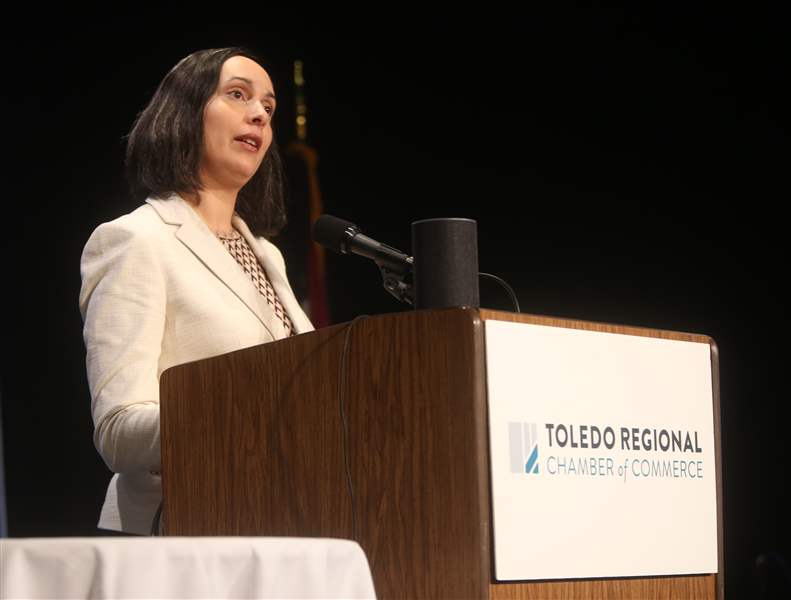
Auto researcher addresses Chamber of Commerce
1/24/2018
Valerie Sathe Brugeman from the Center for Automotive Research in Ann Arbor speaks during the Toledo Regional Chamber of Commerce's 124th annual meeting January 24, 2018. The focus this year was on the role of autonomy in the field of transportation.
The Blade/Jetta Fraser
Buy This Image
Autonomous vehicles seem to hold us spellbound.
The idea that we could hop in a car, bark out a destination, and kick back for a nap is pure sci-fi for many — and yet it’s on our doorstep.
But the truth is that the future of how we get from Point A to Point B is changing in more ways than whether or not we’re at the controls.

Valerie Sathe Brugeman from the Center for Automotive Research in Ann Arbor speaks during the Toledo Regional Chamber of Commerce's 124th annual meeting January 24, 2018. The focus this year was on the role of autonomy in the field of transportation.
Thanks to smartphones, Uber and Lyft have already changed how we hire drivers; car-sharing services provide access to vehicles without having to own one. There are services that will set up carpooling or connect us with a shuttle that will zip us to our final location after stepping off public transportation.
Experts say those kinds of services are only going to grow as cars become more connected and more autonomous.
“Somebody can look on her phone and say, ‘I want to go to Toledo today. What’s the best way to get me there?’” said Valerie Sathe Brugeman, a senior project manager at the Center for Automotive Research. “And it’s pulling from all of those options, including traditional transit, in the most efficient manner possible.”
Ms. Sathe Brugeman was in Toledo to speak at the annual meeting Wednesday of the Toledo Regional Chamber of Commerce, where she outlined both how autonomous cars will revolutionize the automotive industry and how communities need to start thinking about how that will change everything else.
Widespread deployment of highly and entirely automated cars remains a few years out, but chamber officials said they believe it’s important to start these conversations now.
“This is truly disruptive technology, and it is important that communities understand how will that affect us, and how do we react to that,” Chamber president Wendy Gramza said.
Testing of partially and fully autonomous vehicles is happening all over the country, though there are no vehicles available for purchase yet that are completely automated.
The best guess from the Center for Automotive Research is that a limited rollout of cars with high automation will start in shuttle and taxi fleets by 2020, with those cars becoming more widely deployed by 2025 and beginning to enter private ownership a few years after that.
And Americans — while still leery — seem to be coming around to that inevitability.
In a survey released Wednesday, the American Automobile Association found that 63 percent of U.S. drivers said they’re afraid of riding in a fully self-driving vehicle. While that’s a strong majority, it’s down from 78 percent who had similar concerns in early 2017.
“Americans are starting to feel more comfortable with the idea of self-driving vehicles,” Greg Brannon, the auto club’s automotive engineering and industry relations director, said in a statement. “Compared to just a year ago, AAA found that 20 million more U.S. drivers would trust a self-driving vehicle to take them for a ride.”
As these self-driving vehicles are rolled out, experts also expect a big shift in how many people share their commutes with others.
“We think by 2025 vehicle sharing becomes a more viable alternative to ownership. So just in seven to eight years we’re going to see a shift in the level of ownership versus choosing to share a car in whatever form that takes,” Ms. Sathe Brugeman said.
There are all sorts of implications to that. Communities will need to think about the potential loss in parking revenue, how to manage the flow of cars coming into cities to drop off workers, and if cities don’t need parking right downtown, where do they locate parking?
“We’re not going to be necessarily seeing this happen tomorrow, but we are going to be seeing this happening,” Ms. Sathe Brugeman said. “As people, as residents, as constituents, as city representatives, it’s important to think about how you want Toledo and the other regions surrounding Toledo to respond and to be prepared for these technologies.”
Ms. Gramza said Wednesday’s event is a first step in confronting the sea change that’s coming, with plans to hold a series of events addressing some of these issues.
“You can pretend it’s not coming or you can get ready to be part of it and participate in it. With any disruptive technology there are winners and there are losers, and we need to anticipate that,” she said. “There will be all sorts of things that people come up with to make money taking advantage of this new technology.”
Contact Tyrel Linkhorn at tlinkhorn@theblade.com, 419-724-6134, or on Twitter @TyrelLinkhorn.